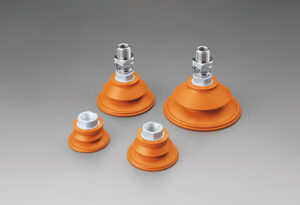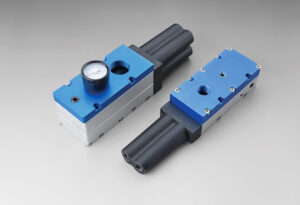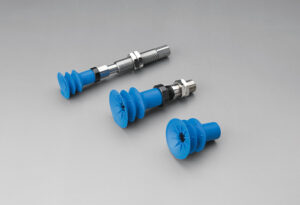Introduction
In the manufacturing world, where precision and reliability are paramount, choosing the suitable materials can make all the difference. The material selection process is a critical aspect of factory operations when it comes to vacuum suction cups, which find extensive use in industries such as robotics, packaging, and material handling. This article will explore how Vacuum Suction Cup factories optimize material selection to achieve enhanced performance.
Understanding the Role of Material in Vacuum Suction Cups
Before delving into the optimization process, it’s essential to grasp the fundamental role that materials play in the functionality of vacuum suction cups. These devices serve as a crucial link between machinery and objects, relying on their ability to grip and manipulate items precisely.
Vacuum Suction Cup factories and manufacturers understand that the choice of materials profoundly impacts performance. Common materials include silicone, polyurethane, and rubber, each offering unique characteristics. Silicone, for instance, provides excellent grip on smooth surfaces, while polyurethane excels in durability and temperature resistance.
The selection process involves a delicate balance between material properties to ensure that the resulting suction cups meet specific application requirements. This requires consideration of load capacity, wear resistance, chemical compatibility, and temperature range.
Factors Influencing Material Selection
In the competitive landscape of Vacuum Suction Cup factory wholesale, factories must meticulously assess several factors when selecting materials for their suction cups. These factors include:
- Load Capacity: Suction cups come in various sizes and shapes, each designed to handle specific loads. Material selection must align with the intended load-bearing capacity.
- Durability: Durability is paramount for applications involving frequent use or exposure to abrasive materials. Manufacturers must choose materials that can withstand wear and tear.
- Temperature Resistance: Industries with extreme temperature variations, such as automotive or food processing, require suction cups that maintain their performance in challenging conditions.
- Surface Compatibility: Different materials adhere differently to various surfaces. Compatibility with the target material is crucial for efficient grip.
- Chemical Resistance: Some industries deal with corrosive substances. Suction cup materials must resist chemical degradation.
Vacuum Suction Cup factories must carefully analyze these factors to select the optimal materials that align with the specific requirements of their clients.
Material Testing and Quality Assurance in Vacuum Suction Cup Factories
Ensuring the reliability and performance of vacuum suction cups is a non-negotiable priority for manufacturers and customers. Vacuum Suction Cup factories implement rigorous material testing and quality assurance procedures to achieve this.
Material Testing and Quality Assurance
- Vacuum Suction Cup manufacturers recognize that material variability can affect performance. To mitigate this, they subject materials to extensive testing regimes. Common tests include:
- Tensile Strength Testing: A material’s ability to withstand pulling forces is crucial for understanding its load-bearing capacity.
- Abrasion Resistance Testing: Simulating real-world wear and tear to evaluate durability, especially in high-use applications.
- Temperature Testing: Subjecting materials to extreme temperatures ensures they maintain their properties in diverse environments.
- Adhesion and Release Testing: Measuring how effectively suction cups grip and release objects is vital to their functionality.
- These tests allow Vacuum Suction Cup factories to identify materials that consistently meet performance standards. By maintaining strict quality control, factories can confidently deliver suction cups that excel in their intended applications.
Sustainable Material Choices
In an era where sustainability is a global concern, Vacuum Suction Cup manufacturers are increasingly opting for eco-friendly materials. This choice aligns with the broader shift towards corporate social responsibility and environmentally conscious manufacturing.
- Sustainable materials, such as recyclable plastics or bio-based compounds, offer comparable performance while reducing the environmental footprint of Vacuum Suction Cup factories.
- By making environmentally responsible choices, manufacturers meet market demands and contribute to a greener future.
The implementation of sustainable materials underscores the commitment of Vacuum Suction Cup factories to performance and environmental stewardship.
Case Studies and Success Stories
To illustrate the tangible benefits of optimized material selection in vacuum suction cup manufacturing, let’s explore some real-world case studies and success stories from Vacuum Suction Cup factories.
Case Study 1: Enhancing Robotic Pick-and-Place Efficiency
A leading manufacturer of vacuum suction cups for robotic automation faced a challenge in a high-speed pick-and-place application. Their initial suction cups experienced premature wear due to constant contact with abrasive materials.
After collaborating with material experts, the factory identified a specialized polyurethane compound with exceptional abrasion resistance. By switching to this material, they extended the lifespan of their suction cups significantly, reducing downtime and maintenance costs for their customers.
Case Study 2: Temperature-Resistant Suction Cups for Automotive Industry
Another factory specializing in vacuum suction cups for automotive assembly lines sought to address the extreme temperature variations in their production process. Traditional silicone suction cups struggled to maintain grip in the heat generated during certain manufacturing stages.
Through careful material selection and testing, the factory introduced silicone blends engineered to withstand high temperatures without compromising performance. This innovation improved efficiency in the assembly line and reduced the need for constant suction cup replacements.
Success Story: Meeting Strict Chemical Compatibility Demands
A manufacturer supplying vacuum suction cups to the chemical processing industry faced a unique challenge – the need for exceptional chemical resistance. Standard materials couldn’t withstand exposure to corrosive chemicals.
After extensive research, the factory identified a specialized material compound that excelled in chemical resistance. Their customized suction cups became a game-changer for clients in chemical processing, reducing downtime and maintenance costs associated with material degradation.
These case studies and success stories highlight the tangible benefits of optimized material selection. Vacuum Suction Cup factories that invest in the research and development of materials tailored to specific applications can provide their customers with solutions that significantly enhance performance and reduce operational costs.
Industry Trends and Innovations in Vacuum Suction Cup Material Technology
In an ever-evolving industrial landscape, staying updated with the latest trends and innovations is crucial for Vacuum Suction Cup factories. Let’s delve into the current industry trends and emerging innovations in vacuum suction cup material technology.
1. Smart Materials for Improved Sensing
One notable trend is the integration of innovative materials into vacuum suction cups. These materials can sense environmental changes, such as temperature or pressure, and adjust their grip accordingly. This innovation is precious in applications where delicate or fragile objects must be handled precisely.
2. Nanomaterials for Enhanced Performance
Advancements in nanotechnology have opened doors to developing nanocomposite materials for suction cups. These nanomaterials offer improved strength, durability, and adhesion properties. They are becoming increasingly popular in industries where high-performance suction cups are required.
3. 3D Printing and Customization
Vacuum Suction Cup manufacturers are exploring 3D printing technologies to create custom suction cups tailored to specific applications. This trend allows for rapid prototyping and cost-effective production of specialized suction cups with unique geometries and material compositions.
4. Enhanced Surface Treatments
In addition to material selection, surface treatments are evolving to enhance suction cup performance. Manufacturers are developing advanced coatings and textures that improve grip, reduce wear, and enhance chemical resistance. These treatments can extend the lifespan of suction cups in demanding applications.
5. Sustainability and Eco-Friendly Materials
As mentioned earlier, sustainability is a growing concern in manufacturing. Vacuum Suction Cup factories actively research and adopt eco-friendly materials and production processes. This aligns with the broader push for environmentally responsible manufacturing and meets the demands of eco-conscious customers.
6. Collaborative Research and Development
Collaboration between Vacuum Suction Cup factories, material scientists, and research institutions is increasing. These partnerships foster innovation by combining industry knowledge with cutting-edge research in materials science.
Staying informed about these trends and innovations is crucial for factory owners and procurement professionals seeking to make informed decisions when purchasing vacuum suction cup systems. These advancements improve performance and contribute to operational efficiency and cost-effectiveness.
Consultation and Customization for Optimal Material Selection
Engaging in talk and customization is paramount for buyers investing in vacuum suction cup systems that precisely align with their operational needs. Let’s delve into how buyers can make informed decisions and customize their suction cup solutions.
Consultation with Vacuum Suction Cup Experts
- Vacuum Suction Cup factories often have experienced engineers and technical experts on staff who can provide valuable insights. Buyers should reach out to these experts for consultation. During these consultations, experts can analyze the application’s specific requirements, considering factors like load capacity, surface material, and environmental conditions.
- Experts can also offer guidance on material selection, providing information on the advantages and disadvantages of different materials based on the application’s demands. They can help buyers choose materials that optimize performance, durability, and cost-effectiveness.
Customization Options
- Many Vacuum Suction Cup manufacturers offer customization options to meet the unique needs of buyers. Customization can involve tailoring the shape, size, and material of suction cups to match the application requirements.
- Buyers should discuss their customization needs with the manufacturer, outlining their requirements. This collaboration can result in suction cups ideally suited to the intended task.
Material Samples and Testing
- Buyers can request material samples and conduct their testing to ensure the selected material meets their performance expectations. This process allows for real-world validation of the material’s suitability for the application.
- Vacuum Suction Cup factories can provide samples for testing, and buyers should take advantage of this opportunity to assess grip strength, wear resistance, and other critical parameters.
Conclusion:
In conclusion, optimizing material selection in vacuum suction cup systems is a crucial factor in achieving enhanced performance. Buyers of these systems should take advantage of consultations with experts and explore customization options to ensure the chosen suction cups meet their specific requirements.
By understanding the role of materials, staying informed about industry trends, and actively engaging in the selection process, buyers can make informed decisions that improve efficiency, reduce maintenance costs, and enhance overall performance.
For buyers interested in exploring the benefits of optimized material selection in vacuum suction cup systems or those seeking consultation and customization options, we invite you to contact our team of experts at [Factory Name]. Contact us today to discuss your needs and discover how the correct material selection can elevate your operations.








